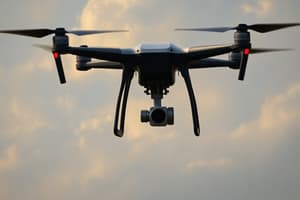Podcast
Questions and Answers
What is the role of the Remote Pilot In Command (PIC) in sUAS operations?
What is the role of the Remote Pilot In Command (PIC) in sUAS operations?
- They hold final authority and responsibility for the operation and safety of the sUAS. (correct)
- They assist in maintaining visual line of sight.
- They manage administrative responsibilities associated with the UAS.
- They directly control the unmanned aircraft from within the cockpit.
Which component is NOT part of the Unmanned Aircraft System (UAS)?
Which component is NOT part of the Unmanned Aircraft System (UAS)?
- Control components required for operation
- Unmanned Aircraft (UA)
- Communication links
- Navigation software (correct)
What is required for an operation to be considered Visual Line of Sight (VLOS)?
What is required for an operation to be considered Visual Line of Sight (VLOS)?
- Use of assisted visual devices at all times.
- Maintaining unaided visual contact with the UA. (correct)
- Availability of a visual observer during the operation.
- Operating the UAS at an altitude above 400 feet.
Who has the authority to select the UAS Commander?
Who has the authority to select the UAS Commander?
What does the term Unmanned Aircraft (UA) refer to?
What does the term Unmanned Aircraft (UA) refer to?
What function does a Visual Observer (VO) perform during sUAS operations?
What function does a Visual Observer (VO) perform during sUAS operations?
Which of the following best describes the responsibilities of the UAS Commander?
Which of the following best describes the responsibilities of the UAS Commander?
What must a pilot be able to do to maintain Visual Line of Sight (VLOS) with a sUAS?
What must a pilot be able to do to maintain Visual Line of Sight (VLOS) with a sUAS?
Who is authorized to deploy a UAS?
Who is authorized to deploy a UAS?
What is the primary purpose of deploying UAS according to the guidelines?
What is the primary purpose of deploying UAS according to the guidelines?
Which of the following is prohibited according to UAS operational guidelines?
Which of the following is prohibited according to UAS operational guidelines?
What type of agencies can request assistance with the UAS?
What type of agencies can request assistance with the UAS?
What must the Pilot in Command (PIC) ensure regarding UAS flights?
What must the Pilot in Command (PIC) ensure regarding UAS flights?
Which of the following is a valid reason for deploying a UAS?
Which of the following is a valid reason for deploying a UAS?
What is explicitly stated about the use of UAS video equipment?
What is explicitly stated about the use of UAS video equipment?
Which personnel must approve all UAS deployments?
Which personnel must approve all UAS deployments?
What does a Certificate of Waiver of Authorization (COA) pertain to?
What does a Certificate of Waiver of Authorization (COA) pertain to?
Who qualifies as an Authorized Member in the context of UAS operations?
Who qualifies as an Authorized Member in the context of UAS operations?
What is the primary purpose of the guidelines provided for UAS usage?
What is the primary purpose of the guidelines provided for UAS usage?
What role does a Crew Member (UAS) fulfill?
What role does a Crew Member (UAS) fulfill?
Under which regulatory framework is the deployment of UAS governed?
Under which regulatory framework is the deployment of UAS governed?
What is NOT a requirement for someone to be an Authorized Member to operate a UAS?
What is NOT a requirement for someone to be an Authorized Member to operate a UAS?
What differentiates a Remote Pilot in Command from other Crew Members?
What differentiates a Remote Pilot in Command from other Crew Members?
What phrase best describes the intended storage and retrieval policies for data captured by UAS?
What phrase best describes the intended storage and retrieval policies for data captured by UAS?
What is a primary purpose of situational awareness in emergency response?
What is a primary purpose of situational awareness in emergency response?
What role does the UAS Commander play in the UAS program?
What role does the UAS Commander play in the UAS program?
What is one of the main functions of tactical deployment in emergency situations?
What is one of the main functions of tactical deployment in emergency situations?
What is expected of the UAS Commander if they are unavailable?
What is expected of the UAS Commander if they are unavailable?
Who retains ownership of the audio/video recordings generated by UAS deployment?
Who retains ownership of the audio/video recordings generated by UAS deployment?
How does visual perspective support first responders?
How does visual perspective support first responders?
What must UAS personnel refer to for information regarding internally recorded audio/video?
What must UAS personnel refer to for information regarding internally recorded audio/video?
What is a benefit of situational awareness for emergency responders?
What is a benefit of situational awareness for emergency responders?
Flashcards are hidden until you start studying
Study Notes
Introduction
- Guidelines established for the use of Unmanned Aircraft Systems (UAS) by the Kansas City Missouri Police Department.
- Compliance with FAA Title 14 CFR part 107 regulations for UAS operations.
Terminology
- Authorized Member: Operates UAS after completing approved training and holds necessary FAA waivers.
- Certificate of Waiver of Authorization (COA): FAA approval for specific UAS operations.
- Crew Member (UAS): Authorized personnel performing operational duties during UAS use.
- Remote Pilot In Command (PIC): Holds a remote pilot certificate, responsible for the UAS operation's safety.
- UAS Commander: Officer responsible for administrative and reporting aspects of UAS operations, designated by the Chief of Police.
- Unmanned Aircraft (UA): Aircraft operated without direct human intervention.
- Unmanned Aircraft System (UAS): UA including all necessary components for safe operation.
- Visual Line of Sight (VLOS): Unaided visual contact required to maintain operational control of UA.
- Visual Observer (VO): Assists the PIC in ensuring navigational awareness and safety.
Procedures
- Only authorized members can deploy UAS for official duties.
- Compliance with all relevant policies and laws is mandatory.
- Requests for UAS assistance from external agencies must go through the UAS Commander or designated personnel.
- Use only department-issued UAVs unless otherwise approved.
- The PIC must ensure compliance with FAA regulations and state laws.
- Prohibited Uses: UAS video equipment cannot be used for random surveillance, targeting individuals based on characteristics, harassment, or personal business.
Administration
- All UAS deployments require approval from the UAS Commander or authorized supervisory staff.
- Uses of UAS in emergency situations include:
- Scene Documentation: Aerial documentation of crime or accident scenes.
- Search and Rescue: Support for missing person investigations and alerts.
- Situational Awareness: Aid for decision-makers during incidents for effective response planning.
- Tactical Deployment: Support for tactical operations and temporary security measures.
- Visual Perspective: Aerial views for crowd control and traffic management.
- Apprehension Assistance: Support in capturing suspects.
- UAS Commander responsibilities include reporting training needs and appointing crew members in their absence.
- All audio/video records from UAS operations belong to the Kansas City Missouri Police Department.
Studying That Suits You
Use AI to generate personalized quizzes and flashcards to suit your learning preferences.




